外文翻译01-
建筑外文翻译--建筑类型和设计

building types and designA building is closely bound up with people,for it provides with the necessary space to work and live in .As classified by their use ,buildings are mainly of two types :industrial buildings and civil buildings .industrial buildings are used by various factories or industrial production while civil buildings are those that are used by people fordwelling ,employment ,education and other social activities .Industrial buildings are factory buildings that are available for processing and manufacturing of various kinds ,in such fields as the mining industry ,the metallurgical industry ,machine building ,the chemical industry and the textile industry . factory buildings can be classified into two types single-story ones and multi-story ones .the construction of industrial buildings is the same as that of civil buildings .however ,industrial and civil buildings differ in the materials used and in the way they are used .Civil buildings are divided into two broad categories: residential buildings and public buildings .residential buildings should suit family life .each flat should consist of at least three necessary rooms : a living room ,a kitchen and a toilet .public buildings can be used in politics ,cultural activities ,administration work and other services ,such as schools, office buildings,parks ,hospitals ,shops ,stations ,theatres ,gymnasiums ,hotels ,exhibition halls ,bath pools ,and so on .all of them have different functions ,which in turn require different design types as well.Housing is the living quarters for human beings .the basic function of housing is to provide shelter from the elements ,but people today require much more that of their housing .a family moving into a new neighborhood will to know if the available housing meets its standards of safety ,health ,and comfort .a family will also ask how near the housing is to grain shops ,food markets ,schools ,stores ,the library ,a movie theater ,and the community center .In the mid-1960’s a most important value in housing was sufficient space both inside and out .a majority of families preferred single-family homes on about half an acre of land ,which would provide space for spare-time activities .in highly industrialized countries ,many families preferred to live as far out as possible from the center of a metropolitan area ,even if the wage earners had to travel some distance to theirwork .quite a large number of families preferred country housing to suburban housing because their chief aim was to get far away from noise ,crowding ,and confusion .the accessibility of public transportation had ceased to be a decisive factor in housing because most workers drove their cars to work .people we’re chiefly interested in the arrangement and size of rooms and the number of bedrooms .Before any of the building can begin ,plans have to be drawn to show what the building will be like ,the exact place in which it is to go and how everything is to be done.An important point in building design is the layout of rooms ,which should provide the greatest possible convenience in relation to the purposes for which they are intended .in a dwelling house ,the layout may be considered under three categories : “day”, “night” ,and “services” .attention must be paid to the provision of easy commun ication between these areas .the “day “rooms generally include adining-room ,sitting-room and kitchen ,but other rooms ,such as a study ,may be added ,and there may be a hall .the living-room ,which is generally the largest ,often serves as a dining-room ,too ,or the kitchen may have a dining alcove .the “night “rooms consist of the bedrooms .the “services “comprise thekitchen ,bathrooms ,larder ,and water-closets .the kitchen and larder connect the services with the day rooms .It is also essential to consider the question of outlook from the various rooms ,and those most in use should preferably face south as possible .it is ,however ,often very difficult to meet the optimum requirements ,both on account of the surroundings and the location of the roads .in resolving these complex problems ,it is also necessary to follow the local town-planning regulations which are concerned with public amenities ,density of population ,height of buildings ,proportion of green space to dwellings ,building lines ,the general appearance of new properties in relation to the neighbourhood ,and so on .There is little standardization in industrial buildings although such buildings still need to comply with local town-planning regulations .the modern trend is towardslight ,airy factory buildings .generally of reinforced concrete or metal construction ,a factory can be given a “shed ”type ridge roof ,incorporating windows facing north so as to give evenly distributed natural lighting without sun-glare .翻译:建筑类型和设计建筑物与人们有着紧密的联系,他为人们提供必要的空间,用以工作和生活。
电动汽车相关课题外文资料翻译
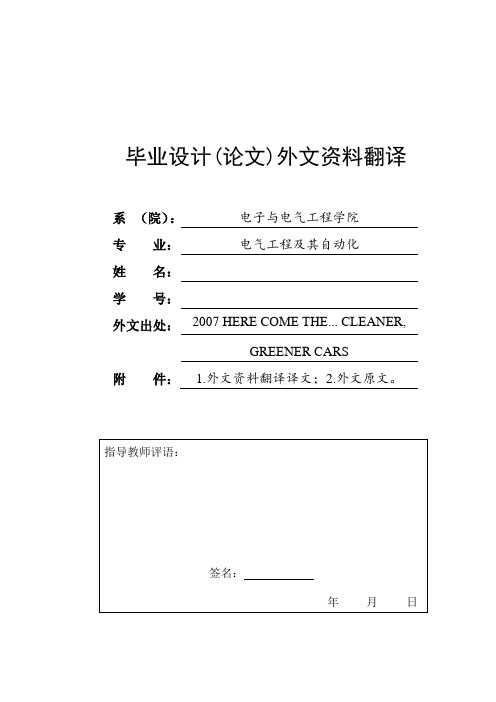
毕业设计(论文)外文资料翻译系(院):电子与电气工程学院专业:电气工程及其自动化姓名:学号:外文出处:2007 HERE COME THE... CLEANER,GREENER CARS附件: 1.外文资料翻译译文;2.外文原文。
附件1:外文资料翻译译文2007年来了...清洁,环保汽车一个全新的领域,在柴油发动机上使用电气混合燃料电池。
这个说法是针对混合动力汽车:美国人爱他们,不过只是猜测。
一些环保人士一直在疑惑,有没有更大的混合电池组,能不能够直接插在墙上进行充电,能不能提供动力让你开车去上班,电力与小型燃气发动机使其变为可能。
这个概念最初是一个环保主义者的梦想,是来自的费利克斯克莱默,他推动了公用事业支持插件的合作。
但现在电动汽车走向市场,就像其他高科技绿色汽车当年发展的情况一样。
清洁汽车新的一天清洁和环保汽车技术正在蒸蒸日上。
可充电混合动力车,在工业发展上展现了比1900年的黄金岁月高很多的研究和开发热情。
当汽油、蒸汽、电动车在市场上进行竞争,许多公司如通用汽车、还在嘲弄像罗杰和我这样的人,是谁扼杀了电动汽车的发展?事实上,美国通用汽车公司是第一个成功制造出了可充电混合动力车的公司,他们使用了一个有趣的新方法。
他们正在研发一种全新的推进系统,在最近的底特律车展上展示,那就是雪佛兰伏特。
随着seesawing对未来石油和汽油价格的不确定性,美国人终于将注意力集中在寻找燃油经济性车辆和展望他们的下一个大型多功能运动型车。
一个由具有很大影响力的公司JD Power and Associates去年夏天对消费者的调查发现,让人吃惊的是有57%的受访者会考虑购买他们的下一个混合动力汽车,有49%的购车者会考虑E85乙醇动力汽车。
另一项由Frost&Sullivan的调查发现约有80%的人更关注较一年前的燃油价格。
几乎有一半的人说,如果燃油价格持续上涨的话他们会考虑购买更省油的汽车或混合动力汽车。
而从居住在美国的市民的调查中发现,有五分之一的让人印象深刻的说道,他们也开始使用替代交通工具:诸如自行车,步行,公共交通和电动汽车等等。
英译汉+01
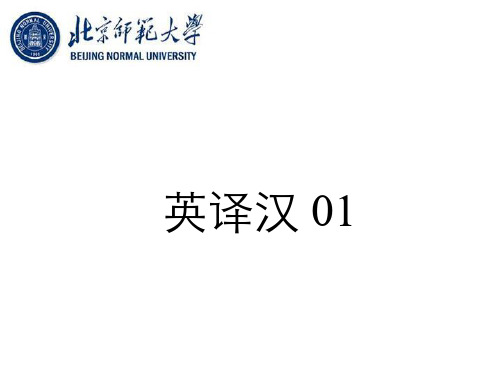
Ha, ha, ha! You'd have betted a hundred pound to five, now, that you wouldn't have seen me here, wouldn't you? 张译:哈!哈!哈!你能跟我打一百镑对五镑的 赌,说你决不会在这儿看到我,是不是? 董译:你一定敢打一个大赌,你不会在这里看见我 的,是不是?
I rose; I dressed myself with care: obliged to be plain- for I had no article of attire that was not made with extreme simplicity- I was still by nature solicitous to be neat. It was not my habit to be disregardful of appearance or careless of the impression I made: on the contrary, I ever wished to look as well as I could, and to please as much as my want of beauty would permit. I sometimes regretted that I was not handsomer; I sometimes wished to have rosy cheeks, a straight nose, and small cherry mouth; I desired to be tall, stately, and finely developed in figure; I felt it a misfortune that I was so little, so pale, and had features so irregular and so marked. And why had I these aspirations and these regrets? It would be difficult to say: I could not then distinctly say it to myself; yet I had a reason, and a logical, natural reason too. However, when I had brushed my hair very smooth, and put on my black frock- which, Quakerlike as it was, at least had the merit of fitting to a nicety- and adjusted my clean white tucker, I thought I should do respectably enough to appear before Mrs. Fairfax, and that my new pupil would not at least recoil from me with antipathy. Having opened my chamber window, and seen that I left all things straight and neat on the toilet table, I ventured forth.
本科毕业设计外文翻译(中文)
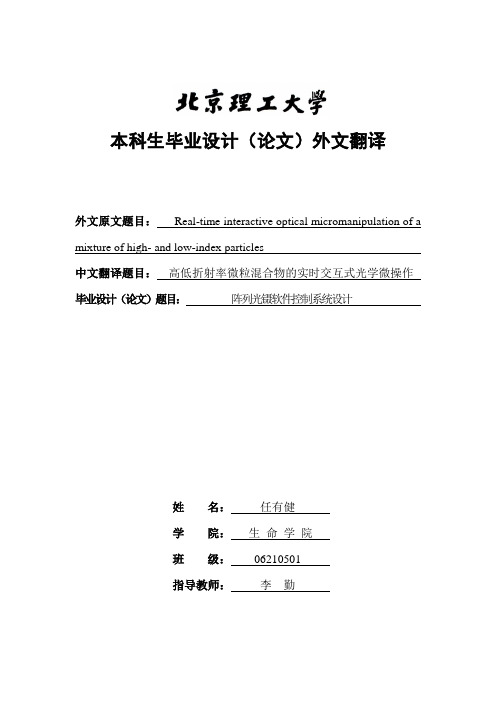
本科生毕业设计(论文)外文翻译外文原文题目:Real-time interactive optical micromanipulation of a mixture of high- and low-index particles中文翻译题目:高低折射率微粒混合物的实时交互式光学微操作毕业设计(论文)题目:阵列光镊软件控制系统设计姓名:任有健学院:生命学院班级:06210501指导教师:李勤高低折射率微粒混合物的实时交互式光学微操作Peter John Rodrigo Vincent Ricardo Daria Jesper Glückstad丹麦罗斯基勒DK-4000号,Risø国家实验室光学和等离子研究系jesper.gluckstad@risoe.dkhttp://www.risoe.dk/ofd/competence/ppo.htm摘要:本文论证一种对于胶体的实时交互式光学微操作的方法,胶体中包含两种折射率的微粒,与悬浮介质(0n )相比,分别低于(0L n n <)、高于(0H n n >)悬浮介质的折射率。
球形的高低折射率微粒在横平板上被一批捕获激光束生成的约束光势能捕获,捕获激光束的横剖面可以分为“礼帽形”和“圆环形”两种光强剖面。
这种应用方法在光学捕获的空间分布和个体几何学方面提供了广泛的可重构性。
我们以实验为基础证实了同时捕获又独立操作悬浮于水(0 1.33n =)中不同尺寸的球形碳酸钠微壳( 1.2L n ≈)和聚苯乙烯微珠( 1.57H n =)的独特性质。
©2004 美国光学学会光学分类与标引体系编码:(140.7010)捕获、(170.4520)光学限制与操作和(230.6120)空间光调制器。
1 引言光带有动量和角动量。
伴随于光与物质相互作用的动量转移为我们提供了在介观量级捕获和操作微粒的方法。
过去数十年中的巨大发展已经导致了在生物和物理领域常规光学捕获的各种应用以及下一代光学微操作体系的出现[1-5]。
外文翻译--微电影广告越来越受欢迎
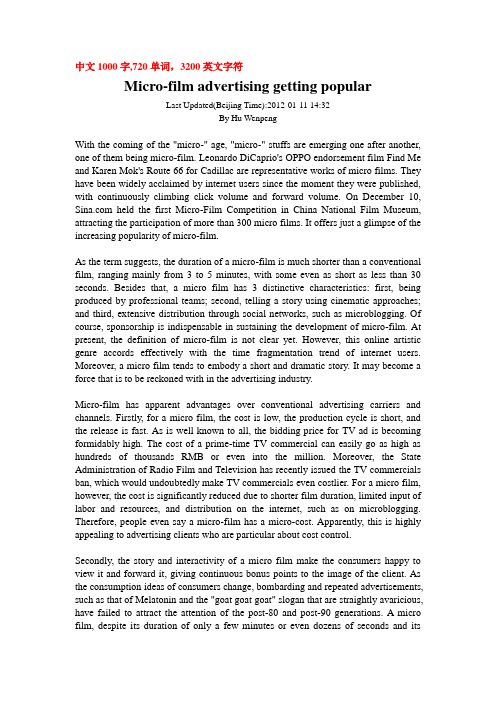
中文1000字,720单词,3200英文字符Micro-film advertising getting popularLast Updated(Beijing Time):2012-01-11 14:32By Hu WenpengWith the coming of the "micro-" age, "micro-" stuffs are emerging one after another, one of them being micro-film. Leonardo DiCaprio's OPPO endorsement film Find Me and Karen Mok's Route 66 for Cadillac are representative works of micro films. They have been widely acclaimed by internet users since the moment they were published, with continuously climbing click volume and forward volume. On December 10, held the first Micro-Film Competition in China National Film Museum, attracting the participation of more than 300 micro films. It offers just a glimpse of the increasing popularity of micro-film.As the term suggests, the duration of a micro-film is much shorter than a conventional film, ranging mainly from 3 to 5 minutes, with some even as short as less than 30 seconds. Besides that, a micro film has 3 distinctive characteristics: first, being produced by professional teams; second, telling a story using cinematic approaches; and third, extensive distribution through social networks, such as microblogging. Of course, sponsorship is indispensable in sustaining the development of micro-film. At present, the definition of micro-film is not clear yet. However, this online artistic genre accords effectively with the time fragmentation trend of internet users. Moreover, a micro film tends to embody a short and dramatic story. It may become a force that is to be reckoned with in the advertising industry.Micro-film has apparent advantages over conventional advertising carriers and channels. Firstly, for a micro film, the cost is low, the production cycle is short, and the release is fast. As is well known to all, the bidding price for TV ad is becoming formidably high. The cost of a prime-time TV commercial can easily go as high as hundreds of thousands RMB or even into the million. Moreover, the State Administration of Radio Film and Television has recently issued the TV commercials ban, which would undoubtedly make TV commercials even costlier. For a micro film, however, the cost is significantly reduced due to shorter film duration, limited input of labor and resources, and distribution on the internet, such as on microblogging. Therefore, people even say a micro-film has a micro-cost. Apparently, this is highly appealing to advertising clients who are particular about cost control.Secondly, the story and interactivity of a micro film make the consumers happy to view it and forward it, giving continuous bonus points to the image of the client. As the consumption ideas of consumers change, bombarding and repeated advertisements, such as that of Melatonin and the "goat goat goat" slogan that are straightly avaricious, have failed to attract the attention of the post-80 and post-90 generations. A micro film, despite its duration of only a few minutes or even dozens of seconds and itsobligation to convey the clients' message, it still manages to tell a thrilling, eye-catching, and memorable story.Li Weiran, a well-known advertisement director, once said: "In today's society, everyone likes stories, especially soul-touching stories". In the middle of this year, the highly popular short film Watch A Football Match tells the story of the adventure of a father and a son, both of who are football fans, in watching a football match. The love of the father and son and the love for football touch the hearts of many online viewers deeply. Within 3 days of its release, the film was clicked 10 million times and forwarded continuously on microblogging.Lastly, the distribution of micro-film on the internet has higher selectivity and pertinence. TV commercials are viewed by all consumer groups. When the product is applicable only for particular groups, there will be wasted input. However, a micro film can be promoted with concentrated efforts in particular regions or among particular crowds based on the internet according the habits and preferences of consumers, further improving the effectiveness and accuracy of the publicity of client's image. Orange Hotel, which has not more than 20 chain stores across the country, made 12 zodiac-theme micro films that target young people. The films rapidly won the hotel the reputation of "good at creating atmosphere" among young white collars.The development of micro-film has just kicked off. It is believed that with the growth of internet-supported technologies and the new-generation consumers, micro-film will play an increasingly important role in the advertising industry.微电影广告越来越受欢迎最后更新(北京时间):2012-01-11 14:32随着“微”时代的到来,与“微”相关的新兴事物层出不穷,其中之一是微电影。
外国历史文学外文翻译 (节选)
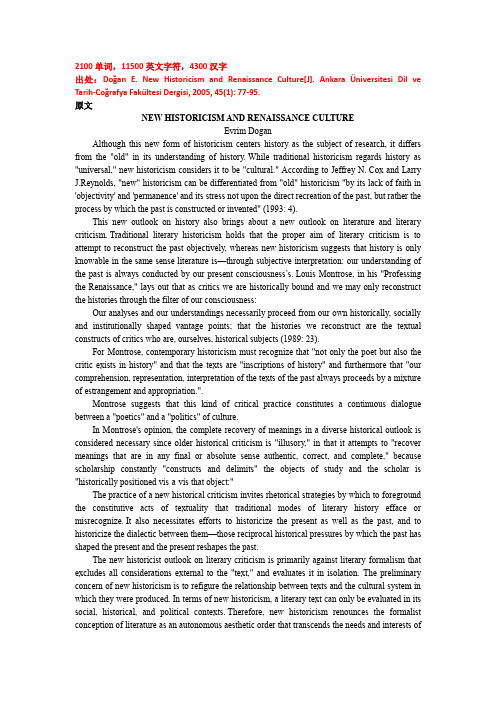
2100单词,11500英文字符,4300汉字出处:Doğan E. New Historicism and Renaissance Culture*J+. Ankara ÜniversitesiDilveTarih-CoğrafyaFakültesiDergisi, 2005, 45(1): 77-95.原文NEW HISTORICISM AND RENAISSANCE CULTUREEvrimDoganAlthough this new form of historicism centers history as the subject of research, it differs from the "old" in its understanding of history. While traditional historicism regards history as "universal," new historicism considers it to be "cultural." According to Jeffrey N. Cox and Larry J.Reynolds, "new" historicism can be differentiated from "old" historicism "by its lack of faith in 'objectivity' and 'permanence' and its stress not upon the direct recreation of the past, but rather the process by which the past is constructed or invented" (1993: 4).This new outlook on history also brings about a new outlook on literature and literary criticism. Traditional literary historicism holds that the proper aim of literary criticism is to attempt to reconstruct the past objectively, whereas new historicism suggests that history is only knowable in the same sense literature is—through subjective interpretation: our understanding of the past is always conducted by our present consciousness’s. Louis Montrose, in his "Professing the Renaissance," lays out that as critics we are historically bound and we may only reconstruct the histories through the filter of our consciousness:Our analyses and our understandings necessarily proceed from our own historically, socially and institutionally shaped vantage points; that the histories we reconstruct are the textual constructs of critics who are, ourselves, historical subjects (1989: 23).For Montrose, contemporary historicism must recognize that "not only the poet but also the critic exists in history" and that the texts are "inscriptions of history" and furthermore that "our comprehension, representation, interpretation of the texts of the past always proceeds by a mixture of estrangement and appropriation.".Montrose suggests that this kind of critical practice constitutes a continuous dialogue between a "poetics" and a "politics" of culture.In Montrose's opinion, the complete recovery of meanings in a diverse historical outlook is considered necessary since older historical criticism is "illusory," in that it attempts to "recover meanings that are in any final or absolute sense authentic, correct, and complete," because scholarship constantly "constructs and delimits" the objects of study and the scholar is "historically positioned vis-a-vis that object:"The practice of a new historical criticism invites rhetorical strategies by which to foreground the constitutive acts of textuality that traditional modes of literary history efface or misrecognize. It also necessitates efforts to historicize the present as well as the past, and to historicize the dialectic between them—those reciprocal historical pressures by which the past has shaped the present and the present reshapes the past.The new historicist outlook on literary criticism is primarily against literary formalism that excludes all considerations external to the "text," and evaluates it in isolation.The preliminary concern of new historicism is to refigure the relationship between texts and the cultural system in which they were produced. In terms of new historicism, a literary text can only be evaluated in its social, historical, and political contexts. Therefore, new historicism renounces the formalist conception of literature as an autonomous aesthetic order that transcends the needs and interests ofa society. A literary text cannot be considered apart from the society that produced it: a literary text is another form of social significance which is produced by the society and in return is active in reshaping the culture of that society. Thus, new historicism explains how texts not only represent culturally constructed patterns, but also reproduce cultural constructions:Contrary to the New Critical insistence on the autonomy of literary texts and on the importance of reading such texts "intrinsically," new historicists believe that it makes no sense to separate literary texts from the social context around them because such texts are the product of complex social "exchanges" or "negotiations".New historicism criticism is one of the most important schools of literary criticism in the 20th century, it is popular in Europe and the United States in the 1980 s literary critic's interest in the Renaissance.The criticism mode is of the twentieth century in Europe and the empirical research center as well as the text research of backwash, is a kind of different from the old historicism and formalism criticism of the "new" methods of literary criticism. This paper mainly illustrates the concept of literary theory to the new historicism criticism. From the Abrams puts forward "world, art, writer, the reader" said four elements, inspected the new historicism criticism in literary theory on the difference of opinion, discusses the criticism method in the whole history of the 20th century western literary criticism of the plays a positive role and the deficiency of this theory own existence.On the theory of new historicism criticism genre. When talking about the criticism genre about literary theory points, this paper emphatically points out that the new historicism criticism is a bottom-up criticism genre, first it is a kind of practice is not doctrine, the biggest characteristic of the new historicism criticism mode is compatible and package. They are dedicated to restore the historical factors in the study of literature and claims will be researched in the social context of the large text, implements the 20th century literature writer center - work - reader’s center - the center of the social transfer. It pursues a kind of new rules in practice "cultural poetics", namely the literature in the whole big culture system, the elements in the literature to full-blown antenna and the cultural interaction and stars appear having a unique style. ABU to discourse, the new historicism criticism to the transformation of four elements, analyzed the new historicism criticism of its own writers of the subject. Writer is composed of the text in the social life or even more is the world of language to construct complete self-shape, remade itself in the form of text again the process of writing down, in this way to achieve the shape of others. In the new historicism criticism of the literary theory of "intersexuality" it is very important. New historicism criticism by Foucault, the influence of Hayden white, history, literature and history at the same level, broke the traditional subordinate relations, a different approach for literary study. New historicism criticism of pay more attention to the ideology of literature and literary theory of the view to overturn and inhibit the collocation, with a new perspective to the essence of the problem. New historicism criticism of macro to make analysis.Thinking this criticism genre, in a sense to the development of the western literary criticism opens up a new way, it by its own practice, active integrate cultural studies of the ocean, with unique criticism mode to win a place in it. It navigates between cultural studies and literary criticism study, by the simple text research mainly into the research on the level of economy, politics, social issues, the new historicism criticism advocating a comprehensive thinking mode, also can be regarded as a subject thinking of too fine a backwash.New historicism criticism from the author center criticism and textual criticism to multiple cultural poetics criticism. At the sametime, it also exists in the process of exploring various defects. First of all, the criticism mainly comes from internal methodology and the concrete practice of contradictions. New historicism criticism in practice and no real formed distinctive criticism method, it explains the problems existing in the literary activities, there are many places can't get rid of the shackle of formalism criticism on methodology. Second, new historicism criticism tend to synchronic to determine in the text of "intertextuality" system, they examined the object of noting have is not starting from the subjective needs, thus ignoring the diachronic investigation on the text in the evolution history of literature development, caused the confusion of time and space. Again, the new historicism criticism has the macroscopic field of vision, but based on the limitations of its history, its history and text are the lack of overall grasp .New historicism criticism will in their own practice and cultural strategy, prompted us to make our own culture reflection in the early new century. New historicism is also critical of deconstruction, which also has an ahistorical method. Nevertheless, it has borrowed certain aspects from post- structuralism like the doctrine of plurality—that a literary work may have different connotations to different people.The theories that are most close to New Historicism are Marxism, Feminism, and Cultural Materialism in their being skeptical of the formalist view of literature as an autonomous realm of discourse.David Forgacs, in his "Marxist Literary Theories," puts forward that regardless of the diversity of Marxist theories, there is one assumption that is final, which is "that literature can only be properly understood within a larger framework of social reality" (1986: 167). This social reality is "not an indistinct background out of which literature emerges or into which it blends" (1986: 167).The literary criticism of New Historicism, one of the most important literary criticism school of 20th century, is different from the traditional historicism and formalism. The critical method has profoundly influenced on the discussion of literary history rewriting and creating of New Historicism novels. The thesis will be helpful to study and compile the 21st century Chinese literary history by interpreting the view of literary history within New Historicism.This thesis consists of three parts. The first part mainly explains the viewpoint of new historicism on history, basing on the history view of Michel Foucault, metahistorical theory of Hayden White and the theory of Louis A. Montrose: the historicity of texts and the textually of histories. It argues that history is not an objective being but a “historical narrative” or “historiography”. Thus history is not only a reappearance of historical events but also an imaginary construction, which derives from some thoughts of historical reality. The most important change is the emergence of the sexuality of history. History changes from “unique story” to “one story”, namely the “History” is replaced by “histories”.The focuses on the view of literary history within the New Historicism, in which the relationship of history and literature totally changed. Literature does not reflect the historical reality any more. History is not the background of literature, either. Literature becomes the union of history and ideology, having a relation of interaction. New Historicism stresses the ideology of literary history, which means a multi-function of literature to ideology: there are consolidation, subversion and containment to subversion.It shows that, on the one hand, literature is created by the network of social power, which demands people to abide by the decrees and contend with current situation; on the other hand,literature often challenges even subverts the hegemony of traditional ideology in some obscure ways.The "definite shape" of social reality is "found in history, which Marxists see as a series of struggles between antagonistic social classes and the types of economic production they engage in" (1986: 167). As Gallagher points out in her "Marxism and New Historicism," one major distinction between new historicism and Marxist criticism is that "the new historicist, unlike the Marxist, is under no nominal compulsion to achieve consistency. She may even insist that historical curiosity can develop independently of political concerns" (1989: 46).Literature, for new historicism, is a social and cultural creation constructed by more than one consciousness, and it cannot be diminished to a product of a single mind. Therefore, the best way of analysis is achieved through the lens of the culture that produced it. Literature is a specific vision of history and not a distinct category of human activity. Man himself is a social construct; there is no such thing as a universal human nature that surpasses history: history is a series of "ruptures" between ages and man. As a consequence, the critic is trapped in his own historicity. No one can rise above their own cultural formations, their own ideological upbringing in order to understand the past in its own terms. Therefore, it is impossible for a modern reader to appreciate a literary work as its contemporaries experienced it. As a result, the best approach to literary criticism is to try to reconstruct the "ideology" of its culture by taking the text as its basis and by exploring diverse areas of cultural factors.Catherine Gallagher explains new historicism as "reading literary and non-literary texts as constituents of historical discourses that are both inside and outside of texts". Gallagher moreover puts forward that the practitioners of new historicism "generally posit no hierarchy of cause and effect as they trace the connections among texts, discourses, power, and the constitution of a subjectivity". Louis Montrose asserts that the focus of this new vein of literary criticism is an attempt to refigure "the socio-cultural field within which canonical renaissance literary and dramatic works were originally produced" and to resituate them "not only in relationship to other genres and modes of discourse but also in relationship to contemporaneous social institutions and non-discursive practices".译文新历史主义和文艺复兴时期的文化艾弗瑞姆·多根虽然这种新形式的历史主义将历史作为研究的中心主题,以区别它与“旧”历史主义。
液压支架外文翻译

汇报人:XX
01 02 03 04
05
Part架英文简称:hydraulic support 液压支架英文简称简写:HS
液压支架的英文名称是"Hydraulic Support System"。
工作原理:利用高压液体驱动立柱升降,实现对顶板的支撑和防护
液压系统:由泵站、控制阀、管路等组成,实现液体压力的传递和控制
动力来源:通常由乳化液泵站提供高压乳化液作为动力源
工作特点:具有高可靠性、高稳定性和高安全性等特点,是现代化矿井中不可或缺的重要装 备之一
采煤作业:液压支架用于支撑采煤工作面的顶板,保护作业人员和设备安 全。
立柱:jack column 底座:base plate
添加标题
Common Problems of Hydraulic Support and their troubleshooting in English Terminolo gy
添加标题
Failure Diagnos is and Repair of Hydraulic Suppor t in English Termino lo gy
维护: Maintenance
保养:Caring
清洗: Cleaning
检查: Inspection
安装:Installation 调试:Commissioning 运行:Operation 维护:Maintenance
Part Five
准确理解原文含义 语言表达清晰流畅 符合目标语言习惯 保持原文风格和修辞手法
掌握专业术语:熟悉液压支架领域的专业词汇和表达方式,确保翻译准确。 了解语言差异:熟悉中英文在语法、句式和表达习惯上的差异,提高翻译流畅度。 参考权威资料:查阅相关外文资料、文献或产品说明书,获取更准确的翻译参考。 实践锻炼:多进行实际翻译练习,通过不断实践提高翻译水平。
外文翻译与文献综述模板格式以及要求说明
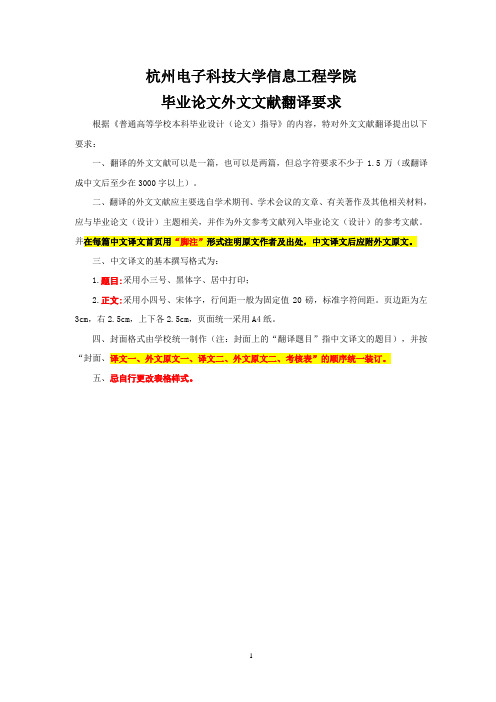
杭州电子科技大学信息工程学院毕业论文外文文献翻译要求根据《普通高等学校本科毕业设计(论文)指导》的内容,特对外文文献翻译提出以下要求:一、翻译的外文文献可以是一篇,也可以是两篇,但总字符要求不少于1.5万(或翻译成中文后至少在3000字以上)。
二、翻译的外文文献应主要选自学术期刊、学术会议的文章、有关著作及其他相关材料,应与毕业论文(设计)主题相关,并作为外文参考文献列入毕业论文(设计)的参考文献。
并在每篇中文译文首页用“脚注”形式注明原文作者及出处,中文译文后应附外文原文。
三、中文译文的基本撰写格式为:1.题目:采用小三号、黑体字、居中打印;2.正文:采用小四号、宋体字,行间距一般为固定值20磅,标准字符间距。
页边距为左3cm,右2.5cm,上下各2.5cm,页面统一采用A4纸。
四、封面格式由学校统一制作(注:封面上的“翻译题目”指中文译文的题目),并按“封面、译文一、外文原文一、译文二、外文原文二、考核表”的顺序统一装订。
五、忌自行更改表格样式。
毕业论文外文文献翻译毕业设计(论文)题目Xxx翻译(1)题目指翻译后的中文译文的题目翻译(2)题目指翻译后的中文译文的题目系会计系以本模板为准)专业XXXXXX(以本模板为准)姓名XXXXXX(以本模板为准)班级XXXXXX(以本模板为准)学号XXXXXX(以本模板为准)指导教师XXXXXX(以本模板为准)正文指导教师对外文翻译的评语:指导教师(签名)年月日建议成绩(百分制)评阅小组或评阅人对外文翻译的评语:评阅小组负责人或评阅人(签名)年月日建议成绩(百分制)杭州电子科技大学信息工程学院本科毕业论文文献综述的写作要求为了促使学生熟悉更多的专业文献资料,进一步强化学生搜集文献资料的能力,提高对文献资料的归纳、分析、综合运用能力及独立开展科研活动的能力,现对本科学生的毕业设计(论文)提出文献综述的写作要求,具体要求如下:一、文献综述的概念文献综述是针对某一研究领域或专题搜集大量文献资料的基础上,就国内外在该领域或专题的主要研究成果、最新进展、研究动态、前沿问题等进行综合分析而写成的、能比较全面地反映相关领域或专题历史背景、前人工作、争论焦点、研究现状和发展前景等内容的综述性文章。
- 1、下载文档前请自行甄别文档内容的完整性,平台不提供额外的编辑、内容补充、找答案等附加服务。
- 2、"仅部分预览"的文档,不可在线预览部分如存在完整性等问题,可反馈申请退款(可完整预览的文档不适用该条件!)。
- 3、如文档侵犯您的权益,请联系客服反馈,我们会尽快为您处理(人工客服工作时间:9:00-18:30)。
2.外文资料原文(与课题相关,至少1万印刷符号以上):
Internet Finance's Impact on Traditional Finance
Ramsey; Labored.
Abstract
As the advances in modern information and Internet technology, especially the develop of cloud computing, big data, mobile Internet, search engines and social networks, profoundly change, even subvert many traditional industries, and the financial industry is no exception. In recent years, financial industry has become the most far-reaching area influenced by Internet, after commercial distribution and the media. Many Internet-based financial service models have emerged, and have had a profound and huge impact on traditional financial industries. "Internet-Finance" has win the focus of public attention.
数据挖掘、云计算以及搜索引擎等技术的发展、金融与互联网机构的技术平台的革新、企业逐利性的混业经营等,为传统金融业的转型和互联网企业向金融领域渗透提供了可能,为互联网金融的产生和发展提供了外在的技术支撑,成为一种外化的拉动力。在互联网“开放、平等、协作、分享”的平台上,第三方融资与支付、在线投资理财、信用评审等模式的不断涌现,不仅使得传统的金融市场格局发生了巨大的变化,也使现代信息科技更加便捷地服务于各金融主体。对于传统金融机构,特别是银行、证券和保险机构而言,机遇大于危机,发展胜过挑战。
4结论
互联网金融模式不仅能够产生巨大的社会效益,降低交易成本,提供比现有直接和间接融资更高的资源配置效率,为经济发展提供动力,还能够借助互联网及其相关软件技术淡化传统金融业的专业分工,使得金融参与者更加大众普通化,风险定价期限匹配等复杂交易也趋于简单化。由于互联网金融所涉足的领域主要集中在传统金融机构当前开发并不深入的领域,即传统金融的“长尾市场”,能够与原有的传统金融业务形成补充态势,所以短期内互联网金融从市场规模角度并不会对传统金融机构带来很大冲击,但是互联网金融的业务模式、创新思路以及其显现出来的高效率对于传统金融机构在理念上带来了较大的冲击,也带动了传统金融机构进一步加速与互联网的互相渗透与融合。
3.2 资金需求者
互联网金融模式下的资金需求者虽然没有突破传统的政府、企业和个体的范畴,但在惠及范围上却有着很大程度的改变。互联网金融的兴起和发展,特别是互联网企业的进入使得被排挤在传统金融机构门槛之外的、相对弱势的组织和个体需求者,有了一个更加便捷和高效的资金获取渠道。因此,互联网金融所带来的普惠性和包容性更胜以往的传统金融模式。
互联网金融低成本、高效率、关注用户体验,这些特点使其能够充分满足传统金融“长尾市场”的特殊需求,灵活提供更为便捷、高效的金融服务和多样化的金融产品,大大拓展了金融服务的广度和深度,缩短了人们在时空上的距离,建立了一种全新的金融生态环境;可以有效整合、利用零散的时间、信息、资金等碎片资源,积少成多,形成规模效益,成为各类金融服务机构新的利润增长点。此外,随着互联网金融的不断渗透和融合,将给传统金融行业带来新的挑战和机遇。互联网金融可以促进传统银行业的转型,弥补传统银行在资金处理效率、信息整合等方面的不足;为证券、保险、基金、理财产品的销售与推广提供新渠道。对于很多中小企业来说,互联网金融拓展了它们的融资渠道,大大降低了融资门槛,提高了资金的使用效率。但是,互联网金融的跨行业性决定了它的风险因素更为复杂、敏感、多变,因此要处理好创新发展与市场监管、行业自律的关系。
3.4 大数据金融
大数据金融是指集合海量非结构化数据,通过对其进行深度挖掘与实时分析,掌握客户的交易信息、消费信息和消费习惯等,进而准确预测客户行为,使相关金融机构在产品设计、精准营销和风险管理等方面的效率得到极大提高。基于大数据的金融服务平台主要指拥有海量交易数据的电子商务企业所开展的金融服务。大数据的关键是从大量无序的数据中快速攫取有价值信息的能力,或者是从大数据资产中快速变现的能力。因此,大数据的信息处理往往与云计算结合在一起。
2016年 2 月 21 日
1.外文资料翻译译文(约3000汉字):
互联网金融对传统金融的影响
作者:罗萨米 ;拉夫雷特
摘要
网络的发展,深刻地改变甚至颠覆了许多传统行业,金融业也不例外。近年来,金融业成为继商业分销、传媒之后受互联网影响最为深远的领域,许多基于互联网的金融服务模式应运而生,并对传统金融业产生了深刻的影响和巨大的冲击。“互联网金融”成为社会各界关注的焦点。
2.1 需求型拉动因素
传统金融市场存在严重的信息不对称,极大的提高了交易风险;移动互联网的发展逐步改变了人们的金融消费习惯,对服务效率和体验的要求越来越高;此外,运营成本的不断上升,都刺激着金融主体对于金融创新与改革的渴求;这种由需求拉动的 因素,成为互联网金融产生的强大内融”属于最新的业态形式,对互联网金融进行探讨研究的文献不少,但多缺乏系统性与实践性。因此本文根据互联网行业实践性较强的特点,对市场上的几种业务模式进行概括分析,并就传统金融行业如何积极应对互联网金融浪潮给出了分析与建议,具有较强的现实意义。
2互联网金融的产生背景
互联网金融是以互联网为资源平台,以大数据和云计算为基础的新金融模式。互联网金融借助于互联网技术、移动通信技术来实现资金融通、支付和信息中介等业务,是传统金融业与以互联网为代表的现代信息科技(移动支付、云计算、数据挖掘、搜索引擎和社交网络等)相结合产生的新兴领域。不管是互联网金融还是金融互联网,只是战略上的区别,并没有严格定义区分。随着金融与互联网的相互渗透与相互融合,互联网金融可以泛指一切通过互联网技术来实现资金融通的行为。互联网金融是互联网与传统金融相互渗透和融合的产物,这种崭新的金融模式有着深刻的产生背景。互联网金融的出现既源于金融主体对于降低成本的强烈渴求,也离不开现代信息技术迅猛发展提供的技术支撑。
